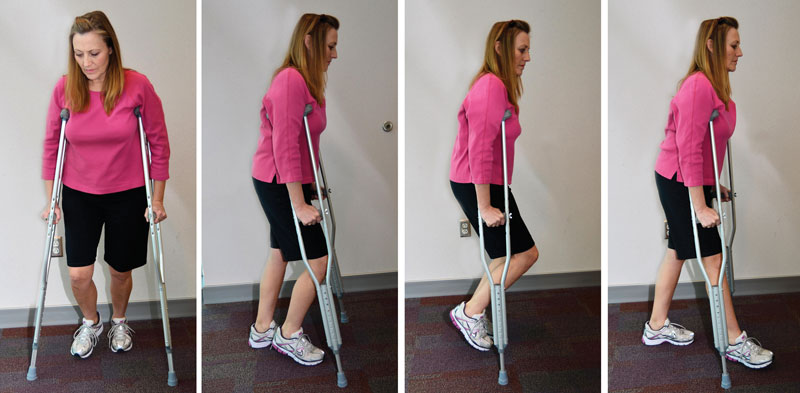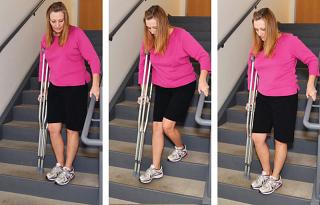In the Hospital
The day of your surgery, your physical therapist will get you out of bed for the first time. The physical therapist will help you walk with a walker or crutches, as you will be allowed to put as much weight on your legs as you would like. You can also sit in a chair that afternoon and get into the bathroom with the help of either the nurses or therapist.
Each day the amount of walking and time sitting in the chair should increase as you can tolerate. Before you go home, the therapist will teach you how climb stairs safely to protect your new knee.
Your physical therapist will show you the exercises you should be doing at home. Exercise will help you regain the strength in your hips and legs so can walk more easily.
Crutch Safety
 Keep the pressure or weight on your hands and not on your armpits. Nerve damage can result if weight is placed on the armpits for too long.
Keep the pressure or weight on your hands and not on your armpits. Nerve damage can result if weight is placed on the armpits for too long.- Keep your elbows close to your side to keep the crutches against your ribs.
- Keep the tips of your crutches two to three inches out to the side of your feet so you do not trip on your crutches.
- Keep a slight bend in your elbow when holding onto the crutches (15–20 degrees).
- Take your time and do not try to walk too fast.
- Keep your head up and look ahead. Do not look at your feet while walking.
- When walking on carpet, you must pick up your crutches and injured leg more than when you walk on tile.
- Remove all throw rugs from the floor to keep from slipping and falling.
Stairs & Curbs
Always use a handrail if one is available.
With Handrail
Going Up 
- Place both crutches under your arm on the opposite side of the rail.
- Grasp the handrail with your other hand, if possible.
- Bring your good leg up to the next step. Let the surgical leg trail behind.
- Straighten your good leg and bring the crutches and surgical leg up.
Going Down
- Put the crutches on lower step.
-
Lower your surgical leg down to the lower step. - Support your weight between your crutch and handrail.
- Move your good foot to the lower step.
Without Handrail
Going Up
- Keep the crutches on the stair you are standing on.
- Support your weight between your crutches.
- Bring your good leg up to the next step. Let your injured leg trail behind.
- Straighten your good leg and bring the crutches and surgical leg up.
Going Down
- Put the crutches on lower step. Support your weight between your crutches.
- Bring your surgical leg down to the lower step. Let your good leg trail behind.
- Bring your good leg down.




